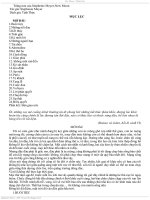a new moon rover
Bạn đang xem bản rút gọn của tài liệu. Xem và tải ngay bản đầy đủ của tài liệu tại đây (3.92 MB, 19 trang )
Moon
Rover
A New
A Nonfiction Narrative
by Susan Halko
Write About
Sun and Stars
Mo o n
Rover
A New
A Nonfiction Narrative
by Susan Halko
The National Aeronautics and Space
Administration (NASA) trains astronauts
to explore the universe. NASA has sent
astronauts to the moon six times. The
last trip was in 1972.
2
NASA plans to send astronauts
back to the moon by 2020.
NASA wants astronauts to
explore more of the moon.
3
In 1972, astronauts used a rover
to explore.
moon rover
4
The astronauts wore space suits
on the rover. Space suits are big
and clumsy. Space suits made it
hard to explore.
5
By 2020, astronauts will want to
explore even more. But they will
not want to wear space suits all
the time.
6
So NASA decided to make a new
moon rover. They would call it the
Lunar Electric Rover, or LER.
7
First, NASA had to think about what
the LER would be like. They wanted the
LER to have big windows. That way
astronauts would be able to get a close
look at the moon from inside the rover.
8
They also wanted the LER to be
covered. That way the astronauts would
not need to wear space suits inside.
9
The space suits would stay outside on
the back of the rover. The LER would
have a small door leading to the suits.
10
Astronauts could climb through the
door and slip right into their suits.
Then they could walk on the moon
and explore more.
11
After scientists built the LER, they needed
to test it. They drove it in a desert in
Arizona. The desert has dry dirt and rocks.
It even has a crater!
crater
Lunar Electric Rover (LER)
12
The moon has dry dirt and rocks,
too. It also has craters.
crater
13
In the desert, the LER rode over bumps
and rocks. Then the LER got a flat tire!
14
People from NASA fixed it. They decided
that the LER should have different tires
when it goes to the moon.
15
NASA is still working on getting
the LER ready for
the trip to the
moon. In 2020,
astronauts will be
glad to have the LER!
16
Author’s
Note
“Part space suit, part sports
car.” This is how one scientist
described the LER. When I
read that, I knew I wanted
to find out more!
So I researched the new
rover on the Internet. I
found lots of interesting
information. I learned that
the new rover has beds,
a shower, and even a
bathroom!
I found pictures, too. When
I first saw a picture of the
LER, I was surprised. It
looked so much different
than the old rovers.
I wanted to tell the story of
the LER. Why did astronauts
want to build it? How was it
going to be better than the
old rovers?
I am excited that astronauts
are working on a new rover.
Someday, you may write
a story about even newer
ways to travel on the moon!
— Susan Halko
Acknowledgments
Grateful acknowledgment is given to the authors, artists, photographers, museums, publishers,
and agents for permission to reprint copyrighted material. Every effort has been made to secure
the appropriate permission. If any omissions have been made or if corrections are required,
please contact the Publisher.
Photographic Credits
Cover (bg) Stockbyte/Getty Images, (inset) Regan Geeseman/NASA - Johnson Space Center;
Title (bg) NASA - Johnson Space Center (NASA-JSC)/NASA Image Exchange; 2-3 (bg) Bruce
Heinemann/Photodisc/Alamy Images; 2 (t inset) David R. Scott/NASA - Johnson Space Center,
(b inset) NASA Marshall Space Flight Center (NASA-MSFC)/NASA Image Exchange; 3 (inset) James
Blair/NASA/Handout/Corbis; 4-5 (bg) Harrison H. Schmitt/NASA - Johnson Space Center; 4 (inset)
NASA Headquarters - Greatest Images of NASA (NASA-HQ-GRIN); 5 (inset) NASA; 6-7 (bg)
NASA - Johnson Space Center; 7 (inset) Regan Geeseman/NASA - Johnson Space Center; 8-9 (bg)
Brian Adducci/iStockphoto; 8 (inset) Regan Geeseman/NASA - Johnson Space Center; 9 (inset)
Robert Markowitz/NASA - Johnson Space Center; 10 NASA - Johnson Space Center; 11 (t) Regan
Geeseman/NASA - Johnson Space Center, (c, b) Robert Markowitz/NASA - Johnson Space Center;
12 (t) Oleksandr Buzko/iStockphoto, (b) PhotoDisc/Getty Images; 13 (bg) NASA, (inset) NASA
Marshall Space Flight Center (NASA-MSFC)/NASA Image Exchange; 14-15 (bg) Brian Adducci/
iStockphoto; 15 (inset) NASA - Johnson Space Center; 16 Emilio Ereza/Alamy Images.
Neither the Publisher nor the authors shall be liable for any damage that may be caused or
sustained or result from conducting any of the activities in this publication without specifically
following instructions, undertaking the activities without proper supervision, or failing to comply
with the cautions contained herein.
Program Authors
Kathy Cabe Trundle, Ph.D., Associate Professor of Early Childhood Science Education, The Ohio
State University, Columbus, Ohio; Randy Bell, Ph.D., Associate Professor of Science Education,
University of Virginia, Charlottesville, Virginia; Malcolm B. Butler, Ph.D., Associate Professor
of Science Education, University of South Florida, St. Petersburg, Florida; Nell K. Duke, Ed.D.,
Co-Director of the Literacy Achievement Research Center and Professor of Teacher Education
and Educational Psychology, Michigan State University, East Lansing, Michigan; Judith Sweeney
Lederman, Ph.D., Director of Teacher Education and Associate Professor of Science Education,
Department of Mathematics and Science Education, Illinois Institute of Technology, Chicago,
Illinois; David W. Moore, Ph.D., Professor of Education, College of Teacher Education and
Leadership, Arizona State University, Tempe, Arizona
The National Geographic Society
John M. Fahey, Jr., President & Chief Executive Officer
Gilbert M. Grosvenor, Chairman of the Board
Copyright © 2011 The Hampton-Brown Company, Inc., a wholly owned subsidiary of the National
Geographic Society, publishing under the imprints National Geographic School Publishing and
Hampton-Brown.
All rights reserved. No part of this book may be reproduced or transmitted in any form or by
any means, electronic or mechanical, including photocopying, recording, or by an information
storage and retrieval system, without permission in writing from the Publisher.
National Geographic and the Yellow Border are registered trademarks of the National
Geographic Society.
National Geographic School Publishing
Hampton-Brown
www.NGSP.com
Printed in the USA.
RR Donnelley, Johnson City, TN
ISBN 978-0-7362-7664-1
10 11 12 13 14 15 16 17
10 9 8 7 6 5 4 3 2 1
Writing Nonfiction Narrative
1









